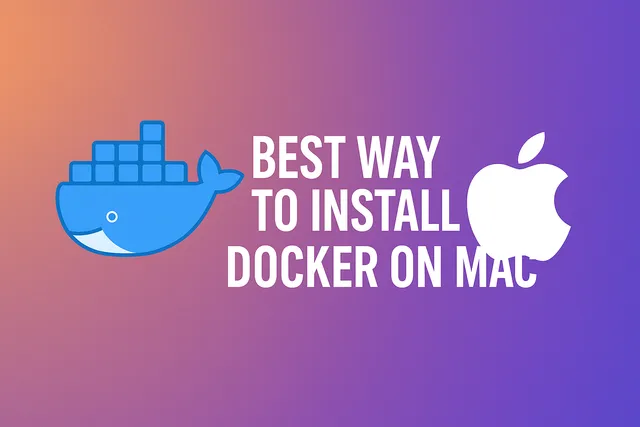
Best Way to Install Docker on Mac
docker mac colima containersDocker Desktop for Mac can be resource-heavy and slow. Colima provides a lightweight, free alternative that’s faster and more efficient. In this tutorial, you’ll learn how to uninstall Docker Desktop and install Colima with Docker’s command-line tools using Homebrew.
Prerequisites
Before we begin, make sure you have:
- macOS (this tutorial is optimized for Mac)
- Homebrew installed (Install Homebrew if you haven’t already)
Step 1: Uninstall Docker Desktop
First, let’s remove Docker Desktop to avoid conflicts:
# Stop Docker Desktop if it's running
osascript -e 'quit app "Docker"'
# Remove Docker Desktop application
sudo rm -rf /Applications/Docker.app
# Remove Docker Desktop files
rm -rf ~/Library/Group\ Containers/group.com.docker
rm -rf ~/Library/Containers/com.docker.docker
rm -rf ~/.dockerStep 2: Install Colima and Docker CLI
The fastest way to get Colima installed is through Homebrew:
brew install colimaOnce Colima installs, install Docker and Docker Compose:
brew install docker docker-composeStep 3: Configure Docker Compose Plugin
Configure docker-compose as a Docker plugin so you can use docker compose instead of the legacy docker-compose script:
# Create Docker CLI plugins directory
mkdir -p ~/.docker/cli-plugins
# Symlink docker-compose to the plugins directory
ln -sfn $(brew --prefix)/opt/docker-compose/bin/docker-compose ~/.docker/cli-plugins/docker-composeTest the installation:
docker composeYou should see the help message confirming the installation.
Step 4: Install Docker Buildx
Install Buildx for building Docker containers:
brew install docker-buildxSymlink it to the CLI plugins folder:
ln -sfn $(brew --prefix)/opt/docker-buildx/bin/docker-buildx ~/.docker/cli-plugins/docker-buildxStep 5: Start Colima
Colima works by using a virtual machine to run containers, similar to Docker for Mac. On first run, it will download and configure a VM with 2 CPUs, 2GiB memory, and 60GiB storage.
colima startYou’ll see output similar to:
INFO[0000] starting colima
INFO[0000] creating and starting ... context=vm
INFO[0041] provisioning ... context=docker
INFO[0074] doneStep 6: Test Your Installation
Run Docker’s hello-world image to verify everything works:
docker run hello-worldYou should see output confirming Docker is working correctly.
Step 7: Basic Docker Operations
Let’s test some basic Docker operations:
List containers
docker ps -aList images
docker imagesRemove containers and images
# Remove a container (replace with your container name)
docker rm <container_name>
# Remove an image (replace with your image ID)
docker rmi <image_id>Step 8: Build Your Own Image
Create a simple test project to verify building works:
# Create project directory
mkdir docker-test && cd docker-test
# Create HTML directory and file
mkdir html
cat <<EOF > html/index.html
<h1>Hi from Docker</h1>
EOF
# Create Dockerfile
cat <<EOF > Dockerfile
FROM nginx:latest
COPY ./html /usr/share/nginx/html
EOF
# Build the image
docker build -t docker-nginx-test .
# Run the container
docker run --rm -t -p 3000:80 docker-nginx-testVisit http://localhost:3000 in your browser to see your custom page.
Customizing Colima’s Virtual Machine
You can customize the VM settings based on your needs:
Change CPU and Memory
# Stop current VM
colima stop
# Start with custom settings
colima start --cpu 4 --memory 4Create VM with More Disk Space
colima start --cpu 4 --memory 4 --disk 100Enable Kubernetes Support
# Install kubectl first
brew install kubectl
# Start with Kubernetes
colima start --with-kubernetesUseful Colima Commands
# Check status
colima status
# Stop Colima
colima stop
# Delete Colima VM
colima delete
# View all options
colima help startPerformance Benefits
Colima offers several advantages over Docker Desktop:
- Faster startup: Colima starts in seconds vs minutes
- Lower resource usage: Uses less CPU and memory
- Free and open source: No licensing fees
- Command-line focused: Better for automation and CI/CD
- Customizable: Full control over VM settings
Troubleshooting
If Docker commands fail
# Restart Colima
colima stop
colima start
# Check Docker context
docker context lsIf you need to reset everything
colima delete
colima startConclusion
Colima provides a lightweight, efficient alternative to Docker Desktop for Mac. It’s faster, uses fewer resources, and gives you more control over your container environment. The setup is straightforward with Homebrew, and you get all the Docker functionality you need without the overhead of Docker Desktop.
For more information, visit Colima’s GitHub page or explore colima help for all available options.
Happy containerizing! 🐳